Master the Art of Hanging Pictures on Your Walls


Intro
Hanging pictures on your wall can do wonders for your space, giving it personality and style. Whether you're a proud homeowner or a tenant looking to spruce up your rented quarters, the art of picture hanging can be approached with both ease and creativity. Getting it right, however, requires a bit of know-how. Imagine stepping back after a long day to admire your carefully curated display of art, family memories, or travel keepsakes. It's not just about slapping something onto a wall—it's about creating an environment that reflects who you are.
A well-placed picture draws the eye, becomes a conversation starter, and makes a house feel like home. But, if you're new to this, it can feel a bit like "fitting a square peg into a round hole"—frustrating and challenging. Fear not! This guide unpacks the essential techniques, tools, and creative strategies you need, ensuring that your wall art journey is a successful one, even if you're starting from scratch.
What to Expect
This article will explore:
- Different hanging methods suited to various wall types.
- The right tools you need at your disposal.
- Essential tips for arranging your artwork.
- Preparing the wall for a smooth installation.
By the end of this guide, you'll be equipped not just to hang pictures, but to elevate your visual space into something truly resonant and striking.
Understanding the Importance of Picture Placement
When it comes to elevating the look and feel of any room, picture placement plays a pivotal role. It's not merely about slapping a frame on the wall; it requires a thoughtful approach to ensure that every piece complements the space, tells a story, or evokes a certain emotion. Misplaced artwork can clutter a wall, while well-placed pictures create a cohesive environment that enhances the overall aesthetic. The careful selection of where to situate your art is, in essence, an art form in its own right.
Creating Visual Balance
Visual balance involves arranging the pictures so they produce a feeling of equilibrium across a wall space. Imagine a seesaw; if one side is heavier than the other, it feels off, and the same principle applies to your wall decor. The art pieces should be distributed in such a way that visually weighs them evenly.
- Consider Size and Shape: Group larger pieces with smaller ones to maintain balance. For instance, a big painting of a serene landscape might be juxtaposed with a few smaller, vibrant abstracts.
- Use Color Wisely: Colors can also affect visual weight. A particularly bright piece might draw attention, so it needs to be placed strategically, perhaps next to more muted works to ensure a pleasing visual distribution.
- Variety in Orientation: Mixing vertical and horizontal frames can also create interest. A continuous horizontal line of smaller prints can harmonize beautifully with a standalone vertical piece.
Visual balance isn't just about symmetry; it's about creating a sense of calm and cohesion that invites the eye to travel leisurely across the wall.
Establishing a Focal Point
Every room needs a focal point — a visual anchor that draws people in. Establishing this with carefully placed pictures can transform how viewers experience a space. A focal point can lead to increased engagement with the room's decor and make the area feel more inviting and intentional.
- Choose One Dominant Piece: This can be an impressive piece of art or a gallery wall that reflects a specific theme. For instance, a large canvas depicting an exotic landscape can become the centerpiece of a travel-themed living room, capturing the essence of adventures while inspiring conversations.
- Positioning Matters: The best spot for a focal piece is often at eye level, ensuring that it catches attention immediately. If it’s too far above or below, it gets overlooked.
- Supportive Elements: Once you’ve chosen your central piece, place other smaller pieces around it. These can act as supporting actors to your primary star, drawing the viewer’s eye back to the main attraction.
Establishing a focal point is more than decorative; it serves a functional aspect by guiding attention while providing visual interest. As walls began to fill, each piece should amplify the narrative you are weaving through your living space.
Tools and Materials Required
Hanging pictures isn’t just a task; it’s a way to etch your personal style into the walls of your home. To kickstart this journey, having the right tools and materials is crucial. The importance of understanding what you need cannot be overstated. The right equipment not only ensures the safety of your precious art but also simplifies the hanging process, making it efficient and error-free.
When you gather the necessary items, you set yourself up for success. It’s worth noting that investing in good-quality tools can pay off in the long run, especially if you plan to rearrange or update your wall decor regularly.
Essential Hand Tools
Before you dive into hanging your artwork, you need some basic tools in your toolbox. Here’s a brief rundown:
- Hammer: A hammer is essential for driving nails into the wall. You might think any hammer will do, but having one with a comfortable grip can make a world of difference.
- Screwdriver: Not just for furniture assembly, screwdrivers help with wall anchors that often come with frames. A versatile set with both flathead and Phillips screwdrivers is a smart bet.
- Level: An absolute must for achieving that straight, professional look. Without one, you might as well be just guessing where to put that picture.
- Measuring Tape: Precision is key when it comes to hanging pictures. A measuring tape helps ensure that you center everything perfectly.
- Pencil: Something as simple as a pencil can be your best friend. Use it to mark where your nails or hooks will go—these marks wash off easily without damaging the wall.
These tools are the backbone of your picture-hanging journey and might even inspire you to take on other DIY projects.
Hanging Hardware Options
Choosing the right hanging hardware is as important as the tools themselves. The options you have will depend on the weight and type of your artwork. Here’s what you should consider:
- Nails and Picture Hooks: These are basic but effective. A good picture hook distributes weight and relieves pressure on your walls.
- Wall Anchors: For heavier frames, wall anchors can provide additional support. These are particularly useful if you are hanging items on drywall without a stud behind it.
- D-Rings and Wire: Many frames come equipped with these; they offer versatility in hanging. If your artwork is heavy, this might be the best route to take for safety.
- Adhesive Strips: If you’re renting or don’t want to commit to drilling holes, these strips can be a game-changer. They generally hold well and peel off clean, but be aware of the weight limits.
Consider the weight and dimensions of your artwork when selecting your hanging hardware. When it comes to preserving your walls and your art, it’s always better to err on the side of caution.
Choosing the Right Picture Frames
Frames are not mere boundaries for your art; they're the frame-works that set the tone of the room. When selecting picture frames, consider the following:
- Material Matters: Wood, metal, or even plastic can change how your piece is perceived. Wooden frames bring warmth; metals give a modern feel.
- Simplicity vs. Style: A simple frame can sometimes elevate the artwork, while a decorative one can complement its character. Choose wisely based on what you're displaying.
- Size and Proportions: Larger pieces need proportionately bigger frames, while smaller artwork can benefit from smaller, simpler designs. Always keep visual balance in mind.
- Color Coordination: The frame's color should either complement the artwork or create a strong contrast. Think about how the frame integrates with the wall colors and other decor.
In short, the right framing can enhance the story your art tells while reinforcing your overall decor scheme. Every detail counts in achieving that stylish finish you’re after.
"The beauty of art lies not just in the piece itself, but in how it’s presented. A well-chosen frame can transform the ordinary into the extraordinary."
Embarking on your picture-hanging quest requires more than just aesthetics; equipped with the right tools and an understanding of your materials, your walls will soon reflect your personal touch.
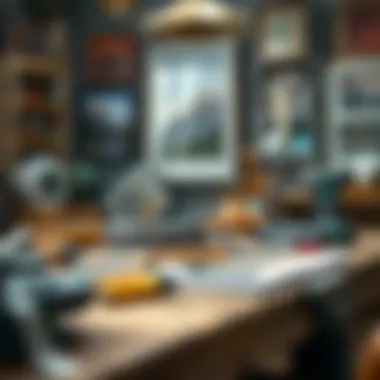
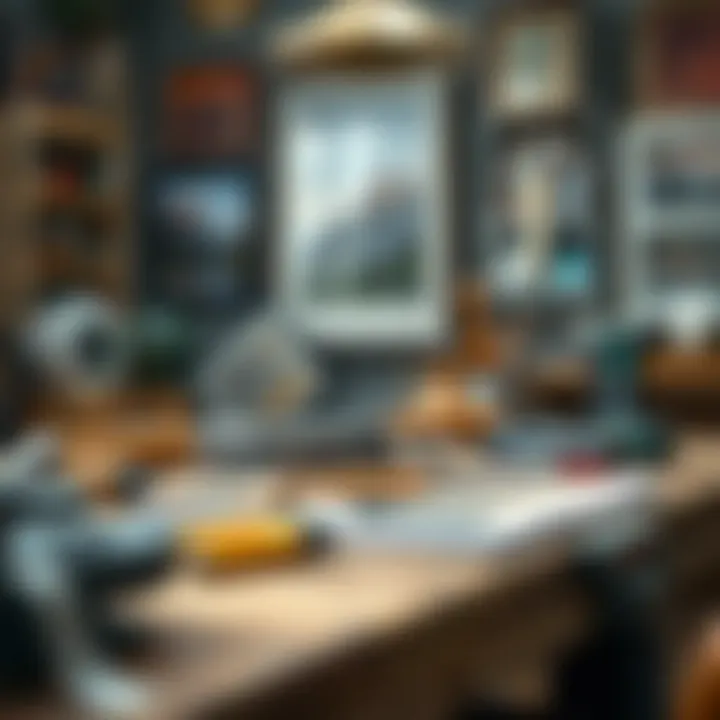
Preparing Your Walls for Picture Hanging
Before you embark on hanging any pictures, it’s crucial to prepare your walls. This preparation can make the difference between a flawless display and a sloppy appearance. Taking the time to ensure your walls are ready will save you both time and frustration in the long run.
Cleaning the Surface
First of all, cleaning the surface of the wall might seem trivial, but every detail counts. Dust, grime, or oily fingerprints can mar the look of even the most beautiful frame. It’s smart to start by wiping down the area with a damp cloth. If there are stains, a mixture of warm water and mild detergent often works wonders. For stubborn marks, a gentle scrub with a soft sponge is advisable. Ensure the wall is dry before attempting to hang anything. A clean wall ensures better adhesion for any hanging hardware and prevents moisture from being trapped behind surfaces – something that could lead to mold or damage.
Identifying Wall Materials
Not all walls are created equal. Knowing your wall material is fundamental to selecting the right tools and hanging techniques. For example, drywall, plaster, and concrete each present their own challenges and require different types of anchors or nails. A quick knock can help you discern if there’s hollow drywall or a sturdy stud behind it. Also, an occasional wall may feature decorative paneling, which could dictate how pictures are hung. Understanding the surface not only influences the aesthetics but also ensures the weight of the picture is adequately supported.
Checking for Studs and Wiring
Before making a single hole, checking for studs or wiring behind the wall is paramount. A stud finder is a handy tool that can help identify vertical beams within walls, giving you a solid anchor point to work with. If hanging heavier pieces, securing them to a stud is often a must.
Moreover, making an educated guess on where electrical wiring runs could save you from a shocking experience—not just literally, but financially too. Drilling into a live wire can not only be dangerous but can also lead to costly repairs. Therefore, it's always wise to ensure you’re drilling in a safe location, away from any hidden hazards.
To summarize, preparing your walls isn't just about aesthetics; it’s about ensuring safety and long-lasting installations. Attention to these details ensures that once you hang those pictures, they will remain secure and looking beautiful for years to come.
Selecting the Perfect Location
Choosing where to hang your pictures is crucial, as it sets the tone for the entire room. An effectively selected location can transform a dull wall into a captivating display, enhancing the overall atmosphere of your space. It's not just about where it looks good; it’s about where it feels right. You need to appreciate how the placement interacts with the layout, design, and even the flow of movement within the area.
Analyzing Room Layouts
When determining the perfect location for your pictures, one must consider the layout of the room. Look for spots that draw the eye and relate to the design elements in the space. For instance, in a long, narrow hallway, a continuous line of images can create a dynamic visual pathway, leading guests from one end to the other.
- Pay attention to influencing features such as furniture arrangements, existing decor, and architectural details.
- Consider if the wall is positioned opposite windows or doors; such areas can frame the artwork effectively, encouraging views from multiple angles.
By keenly observing your space, you can identify zones that enhance not just aesthetics but also the practical flow of the room.
Considering Sight Lines
Once you’ve taken a good look at the layouts, the next step often involves dissecting sight lines. Sight lines are the paths that your eyes naturally follow when entering and navigating through a room. You’ll want to ensure that your pictures are not only visible but also engaging.
For example, art positioned along the line of sight welcomes viewers as they enter the room, fostering an inviting atmosphere. Here’s what to think about:
- What captures your attention immediately? If it’s a certain piece, consider making it the focal point.
- Do any obstacles hinder visibility? Furniture or light fixtures might obscure your artwork.
By aligning your pictures with these elements, you can ensure they contribute positively to the experience of the space.
Eye Level Guidelines
A well-known guideline in the world of interior design is to hang pictures at eye level. This tactic aids in maximizing visual engagement. The typical eye level is estimated to be about 57 to 60 inches from the ground.
- For larger groups or gallery walls, maintaining a consistent center point at this height can create a cohesive look.
- Alternatively, if the room caters to specific groups, such as a children’s play area, adapting the height lower may better suit the audience.
When you adjust your hanging height based on your primary viewers, you cater to their comfort while enhancing the overall appeal of your artwork. Utilizing guidelines for eye level can elevate your designs, making them feel more connected to the space.
"Effective placement is not merely an aesthetic decision; it is about creating harmony and flow throughout the room."
By considering these aspects—room layouts, sight lines, and eye level—you can select the perfect location to hang your pictures, ensuring they are not only seen but appreciated. With careful thought and planning, your decor can truly shine.
Methods for Hanging Pictures
Hanging pictures is not just about slapping a few nails into the wall and calling it a day. The method you choose can vastly impact the look and security of your installation. Embarking on this task requires consideration of your wall type, the weight of your pictures, and the overall aesthetic you’re going for. Each method has its own set of benefits, whether it's simplicity, strength, or versatility. The right choice can elevate your decor while ensuring that your favorite pieces remain secure and undamaged.
Nailing Technique
The nailing technique is the most straightforward method, often preferred for its ease of use. A simple hammer and a sturdy nail can go a long way in achieving a clean, minimalist look. This method works best for lightweight frames. Here are some key pointers:
- Choose the Right Nail: For most pictures, a standard finishing nail or a picture hook nail works well. They are designed to hold light to moderate weights without causing too much damage to the wall.
- Location Matters: Ensure you’re nailing into a stud for heavier frames. You can locate studs with a stud finder or by knocking on the wall until you hear a solid sound.
"A nail in a stud is worth two in the drywall."
This old saying emphasizes the importance of proper placement to avoid disasters down the line.
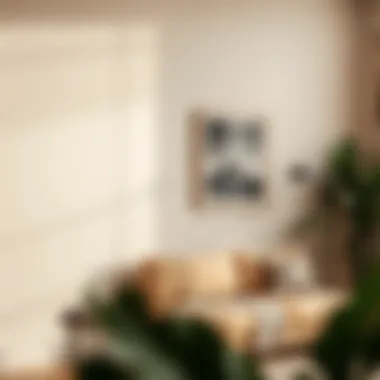
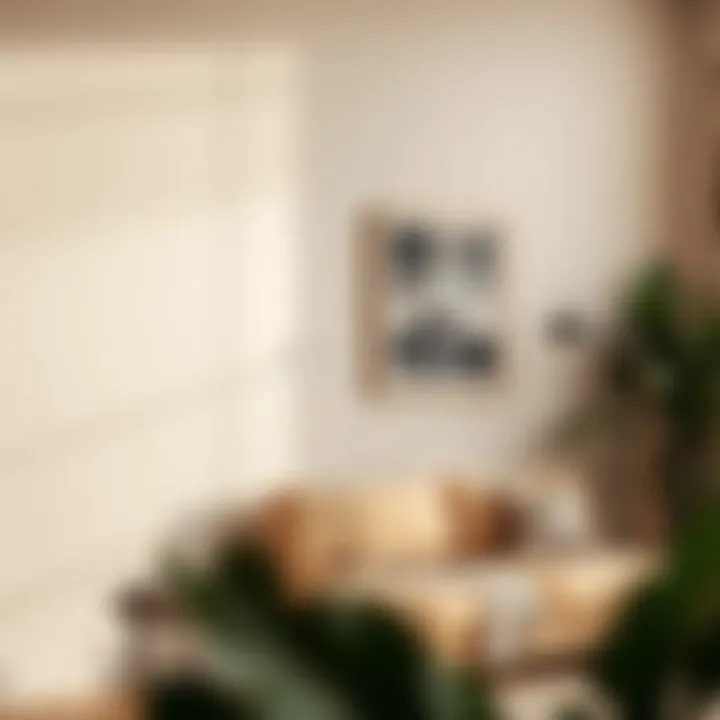
Using Picture Hooks
Picture hooks take the nailing technique a notch higher, providing more support for heavier items. These hooks can be easily installed and adjusted, making them perfect for frames that are on the heavier side. Here’s what to consider:
- Load Capacity: Different hooks are rated for various weights. Always check the packaging to ensure that it can support your frame.
- Versatility: Picture hooks come in different styles, such as single or double-pronged. A double-pronged hook can distribute the weight more evenly, which is particularly useful for larger pieces.
- Damage Control: They’re less likely to tear the drywall when you decide to change your layout. All you have to do is remove the hook and plug any small holes left behind.
Adhesive Strips and Alternatives
For those who want to hang pictures without drilling or nailing, adhesive strips present a viable solution. Command Strips and similar products are particularly handy for renters or anyone who doesn’t want to leave a mark on the walls. Here’s how to use them:
- Clean the Surface: Make sure the wall is clean and dry. Dust or residue can prevent the adhesive from holding strong.
- Weight Limitations: Always adhere to the weight limits provided by the manufacturer. These strips are excellent for lightweight items but may not hold up larger frames.
- Easy Removal: Another perk is that when it’s time to change decor, they can be removed without damaging the paint, assuming you follow the removal instructions.
Systems for Gallery Walls
Creating a gallery wall? This is where hanging systems can shine. This method is about more than simply putting up several frames. It's an art form unto itself. Consider these techniques:
- Track Systems: These systems allow for easy adjustments after installation. Rails are mounted on the wall, allowing hooks and wires to slide along them, making it simple to change the layout.
- Hanging Templates: Using templates can streamline the installation process. Lay out your chosen design on paper, then stick the templates to the wall for guidance on where to hang your images.
- Balance and Composition: Be sure to balance visual weight across your gallery. Odd or even number groupings can have different visual impacts, and the placement should complement the overall room design.
By paying attention to these methods, you ensure that your picture hanging is both functional and visually appealing, making your walls come alive with stories and memories.
Arranging Pictures Aesthetically
When hanging pictures, the arrangement can either make or break the overall aesthetic of a space. A thoughtful arrangement not only showcases personal style but also enhances the atmosphere of your rooms. Getting this right stems from understanding the interplay between the art, frames, and the surrounding decor. It's all about creating a visual narrative that resonates with the viewer, making the need to arrange pictures aesthetically paramount to elevating your home's vibe.
Grid vs. Asymmetrical Layouts
One of the first choices you'll face in arranging your pictures is whether to opt for a grid layout or an asymmetrical one. A grid layout typically presents a clean and orderly feel. This approach often works best in modern and minimalistic settings, where symmetry can create a stimulating focal point. Think of it as a mathematical equation – equal distances, uniform spacing, and consistent frame sizes all add up to a harmonious appearance. For example, positioning four or more identical frames in a square format can illicit a sense of organization and calm.
Conversely, an asymmetrical layout allows for more creativity and freedom. This layout invites a mix of frame styles, sizes, and art pieces that express individuality. It's like a chaotic symphony where every piece competes for attention while still harmonizing together. When employing this method, it’s ideal to balance out larger pieces with smaller ones, ensuring that the overall composition remains visually appealing.
Mixing Frame Styles and Sizes
Don’t be shy about mixing up frame styles and sizes; doing so can breathe fresh life into your wall decor. The juxtaposition of different materials and color finishes often serves as both a statement and an artistic exploration. For instance, if you’re using modern glass frames, pairing those with rustic wooden ones from a flea market can make an intriguing contrast that invokes curiosity.
When considering sizes, think functionally as well as aesthetically. If you have a large wall space, combining a massive canvas with smaller images can create a layered effect that draws the eye throughout the entire display. This tactic not only utilizes the space effectively but also tells a story or conveys a theme, cementing the gallery feel.
Creating a Theme or Story
Incorporating a theme can significantly enhance the visual appeal and emotional engagement of your pictures. Whether it’s a family photo collage that documents various milestones – weddings, birthdays, holidays – or a collection of landscape photography from your travels around the world, each piece should serve a purpose in this household narrative.
To establish a coherent narrative, gather artworks or pictures that connect through color, subject matter, or even emotional tone. This can be particularly powerful when arranging in a hallway or above a sofa. When viewers notice the connection, it makes for more than just an art display; it becomes a reflection of who you are and what you cherish. The story behind each piece can also spark conversations and memories, infusing your environment with deep emotional significance.
"Art enables us to find ourselves and lose ourselves at the same time." – Thomas Merton
In summary, the specifics of arranging pictures are not simply logistical; they embody your personal story and stylistic preferences. Whether you opt for a structured grid, embrace asymmetry, mix frames, or build a themed collection, these choices ultimately determine how your walls come to life.
Maintenance of Hung Pictures
Taking the time to hang pictures beautifully on your walls is undoubtedly just the start of the journey. Maintenance of hung pictures holds significant importance in the overall aesthetic and longevity of your display. A well-maintained gallery doesn’t just look appealing; it also showcases your style effectively over time. Just like a classic car needs a tune-up every so often to keep it running smoothly, your picture display requires regular attention to stay pristine.
Keeping your hung pictures clean and in good shape can enhance the ambience of your home, as the right visual elements can transform an ordinary space into one that feels curated and thoughtfully designed. Dust, dirt, and even the occasional pale spot from sunlight can dull the vibrancy of your artworks and photographs.
Routine Dusting and Cleaning
Cleaning doesn’t have to be a chore; it can be a moment of enjoyment. Think of it as a way to spend time with your collection, appreciating each piece as you go. First, start with general dusting. A soft, lint-free cloth can do wonders. It’s often best to approach this task from top to bottom, ensuring that you aren’t dislodging dust onto just-cleaned areas.
- Use a feather duster or a microfiber cloth to wipe the frame and glass regularly. It can prevent buildup that may scratch the surface if left unattended.
- If the frame or glass needs a more thorough cleaning, a gentle glass cleaner is usually safe for most materials. Just spray it on the cloth, then wipe the surface for best results.
- For hanging pieces without glass, like canvas art, a soft brush or a dry microfiber cloth can be effective.
"Routine maintenance keeps your art looking fresh and your walls happy!"
In addition to dusting, pay attention to the corners and edges of the frames. Those tricky little spots can harbor dust and grime. Make cleaning part of your routine, perhaps along with your seasonal deep cleans, to ensure these treasures shine year-round.
Monitoring for Wear and Tear
Just because a picture has been hanging proudly on your wall doesn't mean it's in perfect condition. It is crucial to monitor for wear and tear, as neglecting this point can lead to irreversible damage. Over time, frames can become loose or even bend, while hanging hardware may weaken.
To keep an eye on the condition of your pictures:
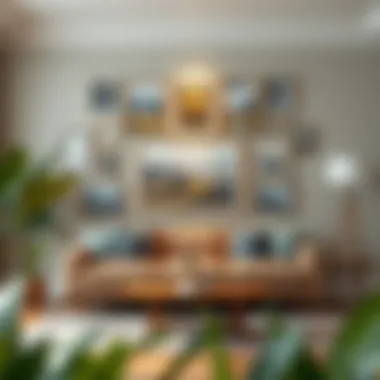

- Regularly inspect the hardware: Take a moment to check if the nails, hooks, or adhesive are holding up well. Replace anything that looks rusty or weakened.
- Look for fading or discoloration: Natural light can be the enemy of your art. If a piece appears to have lightened unevenly, consider relocating it to a less sunny spot.
- Watch for physical distortion: Sometimes, photos can warp due to humidity or temperature changes. If you spot any signs of bending or distortion, it might be time to reframe or restore your pieces.
In essence, engaging in maintenance acts not only prolongs the life of your pictures but also ensures that your wall art continues to express your personality and style beautifully. Taking care of what you have hung makes for a more cohesive and polished look, reflecting a careful curation of art that will be admired for years to come.
Considering Aesthetic Factors
When it comes to hanging pictures, aesthetic factors play a crucial role. The way you arrange art can transform a room, making it reflect your personality and sense of style. This section delves into how color coordination and textural contrasts can enhance your interior spaces, ensuring a seamless integration of your artwork with the overall decor. The purpose is not just to hang pictures, but to create a visual narrative that resonates with the atmosphere of the room.
Color Coordination with Surroundings
Color holds immense power in design. When selecting the right place for your artworks, consider how they interact with the colors around them. Harmonizing colors creates a cohesive look. For instance, a vibrant yellow painting will pop beautifully against a wall painted in a soft, muted gray. On the other hand, hanging that same piece on a white wall may not have the same effect— it might lose its dynamism.
To effectively coordinate colors, you might want to:
- Evaluate the dominant hues in your room. If your furniture is predominantly dark, consider bright or pastel colors for your pictures to create a striking contrast.
- Use a color wheel as a reference. Complementary colors (those opposite each other on the wheel) can create visual interest.
- Keep in mind the mood. Warm colors like reds and oranges can energize a space, while cool colors like blues and greens often represent calmness.
Consider this tip: Use an art piece to pull color from the room. If your curtains are a shade of blue, find an artwork that contains a hint of that shade to ensure everything ties in nicely.
Textural Contrasts
Contrasts in texture can be just as important as color. Mixing different materials adds depth to your arrangement. Maybe you have a sleek, framed photograph on canvas alongside a rustic wooden frame. This combination adds layers to your wall, encouraging the eye to explore rather than settle on flat, one-dimensional images.
Here are elements to focus on for texture:
- Materials: Wood, metal, fabric, and glass can all vary in texture. A shiny metal frame juxtaposed with a matte canvas can create a compelling visual dynamic.
- Frame Styles: Varying the styles of frames can add to the overall textural experience. Don’t shy away from pairing modern frames with vintage artwork; this can create a unique aesthetic contrast.
- Wall Texture: If your wall has its own texture (like brick or stucco), consider how your artwork will interact with that. The artwork can complement or contrast this surface, enhancing the overall appeal.
"Art is not what you see, but what you make others see." — Edgar Degas
Whether you’re aiming for a peaceful retreat or a vibrant social space, understanding these aesthetic principles will guide you toward making informed choices when hanging pictures.
Common Mistakes to Avoid
When it comes to hanging pictures, avoiding common pitfalls can make all the difference in achieving a polished and balanced look. Ignoring these mistakes may lead to frustration or, perhaps worse, a room that feels cluttered or mismatched. Keeping these guidelines in mind ensures that your wall art enhances rather than detracts from your space.
Overcrowding the Space
One of the biggest blunders in picture hanging is overcrowding the space. When you don’t give each piece of art room to breathe, you risk creating a chaotic display that overwhelms the eye. Think of it like a buffet; if too many dishes are crammed on a table, no one knows where to begin. Instead, allow for negative space—those empty areas that give your artwork a chance to stand out.
To avoid this mistake, consider the following:
- Choose a focal point: Select one major piece as the star of the show and arrange smaller accompaniments around it, as supporting cast members. This strategy guides viewers’ eyes and creates a narrative.
- Use a consistent theme: Whether you lean towards a specific color palette or a unified subject matter, keeping a common thread helps tie everything together without overwhelming the senses.
- Leave enough wallspace: A good rule is to leave at least two to three inches between frames, but this can vary depending on the size and style of your wall art. Let your wall breathe; after all, art should invite admiration, not confuse.
Be mindful that less is often more. The best galleries often display only a few exquisite pieces, allowing them to leave a lasting impact.
Inconsistent Heights
Another frequent pitfall is hanging artwork at inconsistent heights. Not only can this make a room feel discordant, but it can also draw unwanted attention to the disparity. Aim for a line of sight that aligns all pieces harmoniously. Imagine going to a concert where the musicians are all standing at different heights—it wouldn’t feel right, would it?
To maintain uniformity:
- Use a level: Before securing any hooks or nails, measure the heights carefully. A spirit level helps ensure that every piece hangs straight, which is key to making the display feel cohesive.
- Follow eye level guidelines: The general rule is to hang artwork at eye level, which is around 57 to 60 inches from the floor to the center of the artwork. With this rule, you can create a visual rhythm that is satisfying to the eye.
- Group items in clusters: When arranging several pieces together, keeping their tops or bottoms aligned can create symmetry. This is especially effective in gallery walls.
Inconsistency can lead to confusion. A well-coordinated height for your pictures invites viewers to take in the art with ease and appreciation.
Tip: Before drilling, consider hanging your art temporarily with painter’s tape. This allows for adjustments without leaving marks.
By steering clear of overcrowding and inconsistent heights, you can craft a gallery-like setting in your home that speaks to a well-thought-out aesthetic. For more about design nuances, check helpful resources such as Britannica and for practical examples, consider visiting discussion threads on Reddit. Keep it simple, steady, and always think ahead!
Final Thoughts on Picture Hanging
Understanding the nuances of picture hanging is essential for creating a space that not only feels personal but also invokes a sense of serenity and style. When it comes to adorning your walls with art, the act extends beyond simply choosing a frame or a spot to place it. It involves a careful consideration of how each piece of art interacts with its surroundings and how it contributes to the overall aesthetic of your home.
Evolving Your Decor with Time
Art and decor trends shift much like the seasons. One day, a minimalistic, Scandinavian style may dominate, while the next, there's a resurgence of bold, eclectic displays brimming with color. As we grow and change, so too should our surroundings. Regularly reassessing your wall art can help keep your environment fresh and engaging.
- Reflecting Changes in Life: As people move through different life stages—graduating, starting families, or pursuing new careers—our tastes and influences evolve. Regular revisions to your wall decor can symbolize those transitions, making space for memories or achievements acquired along the way.
- Mixing Old with New: Don’t hesitate to incorporate new purchases with existing pieces. This creates a visual narrative and tells the story of your life. For instance, pairing a vintage family photo with a contemporary abstract piece can establish a rich dialogue of time and style.
- Keeping it Personal: Rotate artwork based on seasons or sentiments; displaying cherished pieces in the spring may emphasize renewal, while winter might spotlight family traditions.
Adapting to New Trends and Styles
Staying current with trends doesn’t mean you must abandon your original style. Rather, it’s about finding harmony between what is trendy and what feels authentic to you. Today, styles blend and mix more than ever, allowing for personal expression in every nook of your home.
- Embracing Eclecticism: The rise of the gallery wall illustrates this wonderfully. Mixing prints, photographs, and even textiles creates visual interest and reflects personality unlike anything uniform can achieve.
- Sustainability Matters: In recent years, there's been a significant push toward sustainable materials in decor. Choosing pieces crafted from eco-friendly resources is not just trendy; it aligns with a modern consciousness about our environment. Seek artwork made from reclaimed items or support local artists committed to sustainability.
- Incorporating Technology: Digital frames and art displays can also synchronize with trends. They offer a dynamic approach to wall decor, allowing you to present a rotating selection of pieces that can adapt to current whims without requiring constant physical changes.
"Art is not what you see, but what you make others see." – Edgar Degas
In essence, hanging pictures on your wall is both an act of decoration and a means of storytelling. Whether you're evolving your decor with time or adapting to new trends, the key is to cultivate a space that resonates with who you are. A thoughtfully curated wall invites people to connect—not just with the art, but with the essence of the space itself.
Taking the time to ensure your artworks not only fit your space but also reflect your personality will transform your living environment from ordinary to extraordinary. Let your walls speak of experiences, tastes, and values, and enjoy the intricate dance of art with life.















